We loved reading your entries to our '140 characters' contest. The diversity of your entries made our task challenging. Find out the finalists and grand prize winner below, as well as our thoughts on what made these characters compelling and what we can learn from them. At the bottom of the post you can see a word cloud comprised of the most common words used across all 128 entries. It gives basic but interesting insights into our common approaches to describing characters!
The grand prize winner of the 140 characters contest: Evelyn Grace
The grand prize of a copy of a sponsored copy of Scrivener app (as well as lifetime membership to Now Novel and a copy of Bridget's book) is Evelyn Grace. Congratulations, Evelyn! Here's Evelyn's entry:
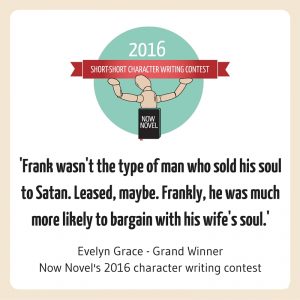
What we loved: We get a clear sense of Frank immediately. Here's a character who is perhaps a little selfish and cunning. The common metaphor of 'selling your soul' could easily be used in a clichéd way, but Evelyn skirts this with humour and the striking idea of using a significant other's soul as a substitute.
We get an immediate impression of Frank as being calculating and unscrupulous. Small touches (the clever choice of the word 'Frankly' echoing the character's name) add to the overall effect and make this stand out as effective character description.
The four finalists/runners up
We need to stress that all 128 entries had their individual merits. The main point of the contest was to inspire everyone to create striking characters from first introduction. Congratulations to the four remaining finalists, who each receive lifetime Now Novel membership and a copy of Bridget's book. In no particular order, they are: Hollis Thundercroft, Kaushik Karforma, Kimberly Gunderson and Laura Wallace. Here are their entries and what made them stand out:
Finalist Hollis Thundercroft
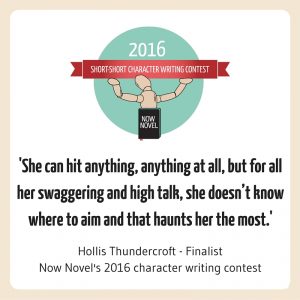
Hollis's entry contains something we (and many other fiction lovers) champion: Characters who aren't too perfect; characters who have flaws. Hollis's description contains a striking contrast between the character's apparent skill and swagger and the indecisiveness that undercuts her claims. There is intrigue - can the character really hit anything, or is this all talk? Is not knowing where to aim a cover-up for her incompetence or is she actually a crack shot who is let down by indecisiveness and incomplete knowledge?
It also raises other questions, as a standalone character description: We know the character uses some sort of projectile weapon, but what? A bow and arrow, a gun, a catty? Questions about the character make us want to keep reading so we can know more.
Finalist Kaushik Karforma
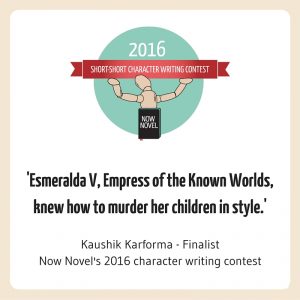
Kaushik's entry is effective because it manages to make a character powerful, ruthless and intriguing using only a handful of words. We learn that the character is part of a long-reigning dynasty, we are told about a mysterious and intriguing setting (the 'Known Worlds') but most importantly we are shocked and made curious by the combination of a woman murdering her own children and doing so 'in style'. This act places the Empress in a long line of literary women who've performed similar disturbing acts (the famous example being Medea, the title character of the Ancient Greek tragedy by Euripides, in which a former princess kills her children to get revenge on her straying husband).
We immediately get a sense of the character as powerful as well as dangerous and merciless. The brief character description also sets up some expectations for the type of society that inhabits the 'Known Worlds'; one where brutal acts can be carried out by those who have power 'in style'.
Finalist Kimberly Gunderson

What we loved about Kimberly's entry: The character is easy to visualize because of the strength of the simile (skin flowing 'like candle wax') and the way the rest of the description supports the sense of wear and weariness. The objects ('worn slippers') are almost an extension of the character's body: They match both her physical appearance ('formerly lithe', in better shape in the past) and the sense of defeat in her words at the end.
In total, the character comes across as having been altered by time and we get a sense of the way time's alterations weigh on her. As with the other entries, there's also an 'unsaid'. Why is the character frustrated at having to face another day? We want to find out what ails her and what her exact circumstances are. The character's voice beckons us into the story, in spite of her seeming unhappiness.
Finalist Laura Cox Wallace
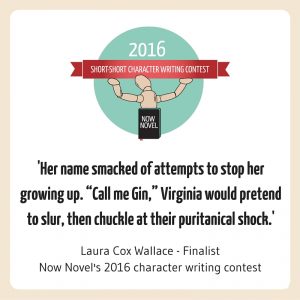
What we loved: Laura's character is again a character of striking contradictions. There is a contrast between her name (with its connotations of innocence and the virginal) and the way she jokes about her name, shortening it to an alcoholic beverage. There's humour in this, and this contrast strikes at the heart of people's endless contradictions and differences.
The names we have and the names we give don't always match the named person or thing. With a light touch, Laura shows us the gulf that sometimes lies between impressions and reality. We are aware that social perceptions and expectations (the puritantical shock people show to Virginia/Gin) sometimes oppose the individual's free self-expression and self-definition.
Thanks again to everyone who entered! We'll be in contact with the final 5 so that we can hand over prizes (please email us at help at now novel dot com so we have reliable contact details, finalists)
Here is the word cloud we made that shows the most common words used across all 128 entries:
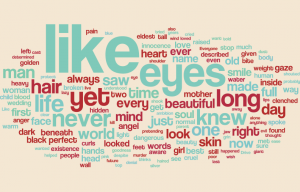
As you can see from the word cloud, 'like' was the most common word used. This is because we reach for similes often when we describe characters, especially their physical appearances. Finalist Kimberly's entry is a prime example of effective, visually striking simile: The character's skin 'flowed like candle wax'.
'Eyes' and 'hair' are two of the other most common physical attributes people use to describe characters. What's also interesting is that these don't feature strongly in our final selection. Think about ways that actions, traits, and relationships to others can also create a strong idea of your character. You can describe your characters through both the senses and through their behaviour in the world. Think about who the reader might know in their own life: They might know 30 or more people who have blue eyes or curly hair, but have they encountered anyone who bargains with other people's souls or finds the liquor hidden in their own name?
Share the word cloud if you find the results as interesting as we did, and keep an eye out for future contests. Our sincere thanks to our sponsor, Scrivener.
If you're ready to start creating blueprints for your story's characters, write a book with the help of the Now Novel process.

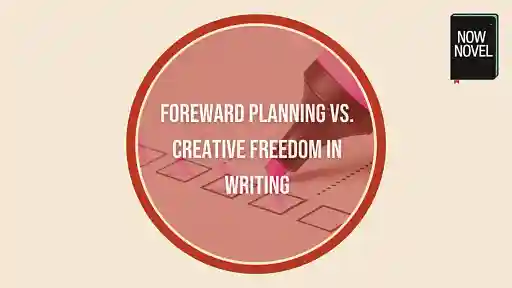







Wow, these sentences are mindboggling. Such inspiration!
Lori Mc Blogger - Over 8 years ago
Glad you enjoyed them, Lori! There are some gems here; we thought so too.
Bridget At Now Novel - Over 8 years ago
OK, these sentences really are excellent - I would want to read whatever these characters are in, especially Frank and the one with the candle-wax skin :) Well done, all!
Pseudomona - Over 8 years ago
Thanks for congratulating everyone, Pseudomona. We also are looking forward to reading more of these stories.
Bridget At Now Novel - Over 8 years ago
I can't find online a catty (mentioned above) as a projectile weapon - I was just curious, but what is it? Is it a cat-o'-nine-tails?
Pseudomona - Over 8 years ago
It's the same thing as a slingshot, an elastic band stretched across the V of a Y-shaped piece of wood.
Bridget At Now Novel - Over 8 years ago
Congrats, winners! Great descriptions. I can almost see the people in my mind's eye.
Ohita Afeisume - Over 8 years ago
Thanks, Ohita! Glad you enjoyed everyone's characters.
Bridget At Now Novel - Over 8 years ago
Congratulations to all the winners. Great character descriptions! @sheilamgood at Cow Pasture Chronicles
Sheila Good - Over 8 years ago
Thanks for reading and for entering too, Sheila!
Bridget At Now Novel - Over 8 years ago
My pleasure. It was fun.
Sheila Good - Over 8 years ago